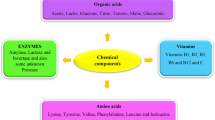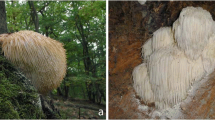Abstract
The extracts and chemical compounds isolated from barnyard millet (Echinochloa utilis) grains were investigated as part of a search for naturally derived anti-hyperglycemic medicinal plants. Among the five different solvent extracts, the ethyl acetate extract showed the lowest IC50 value against Saccharomyces cerevisiae α-glucosidase (70.2 μg/mL). Chromatography yielded eight phenolic compounds that may have been responsible for this effect. Among them, N-p-coumaroyl serotonin (1, CS), feruloyl serotonin (2, FS), and luteolin (5) potently inhibited α-glucosidase with IC50 values of 1.3–17.8 μM compared with those of deoxynojirimycin (DNJ, IC50 = 2.5 ± 0.1 μM) and acarbose (IC50 = 255.1 ± 15.6 μM). Additionally, for the first time, we found that CS and FS were significantly inhibited mammalian rat intestinal sucrase (IC50 of 3.0 and 8.2 μM) and reduced glucose content (73 and 52 % at 0.1 mg/wells) in Caco-2 (human intestinal epithelial) cells. Furthermore, oral glucose tolerance test revealed improved glucose tolerance following treatment with the barnyard millet grains extract by retarding the postprandial rise in blood glucose in vivo. These results suggest that barnyard millet grain can be used as a natural functional medicine to prevent and alleviate type-2 diabetes.




Similar content being viewed by others
References
Adachi TMC, Sakurai K, Shihara N, Tsuda K, Yasuda K (2003) Morphological changes and increased sucrase and isomaltase activity in small intestines of insulin-deficient and type 2 diabetic rats. Endocr J 50:271–279
Benalla W, Bellahcen S, Bnouham M (2010) Antidiabetic medicinal plants as a source of alpha glucosidase inhibitors. Curr Diabetes Rev 6:247–254
Bertozzi CR, Kiessling LL (2001) Chemical glycobiology. Science 291:2357–2364
Gloster TM, Davies GJ (2010) Glycosidase inhibition: assessing mimicry of the transition state. Org Biomol Chem 8:305–320
Hansawasdi C, Kawabata J (2006) Alpha-glucosidase inhibitory effect of mulberry (Morus alba) leaves on Caco-2. Fitoterapia 77:568–573
Huang YN, Zhao YL, Gao XL, Zhao ZF, Jing Z, Zeng WC, Yang R, Peng R, Tong T, Wang LF, Cen JQ, Gao H (2010) Intestinal alpha-glucosidase inhibitory activity and toxicological evaluation of Nymphaea stellata flowers extract. J Ethnopharmacol 131:306–312
Jenkins DJ, Kendall CW, Augustin LS, Martini MC, Axelsen M, Faulkner D, Vidgen E, Parker T, Lau H, Connelly PW, Teitel J, Singer W, Vandenbroucke AC, Leiter LA, Josse RG (2002) Effect of wheat bran on glycemic control and risk factors for cardiovascular disease in type 2 diabetes. Diabetes Care 25:1522–1528
Kim KY, Nam KA, Kurihara H, Kim SM (2008) Potent alpha-glucosidase inhibitors purified from the red alga Grateloupia elliptica. Phytochemistry 69:2820–2825
Kim JY, Lee JW, Kim YS, Lee Y, Ryu YB, Kim S, Ryu HW, Curtis-Long MJ, Lee KW, Lee WS, Park KH (2010) A novel competitive class of alpha-glucosidase inhibitors: (E)-1-phenyl-3-(4-styrylphenyl) urea derivatives. ChemBioChem 11:2125–2131
Kim JY, Jang KC, Park BR, Han SI, Choi KJ, Kim SY, Oh SH, Ra JE, Ha TJ, Lee JH, Hwang JY, Kang HW, Seo WD (2011) Physicochemical and antioxidative properties of selected barnyard millet (Echinochloa utilis) species in Korea. Food Sci Biotechnol 20:461–469
Kimura A, Lee JH, Lee IS, Lee HS, Park KH, Chiba S, Kim D (2004) Two potent competitive inhibitors discriminating alpha-glucosidase family I from family II. Carbohydr Res 339:1035–1040
Leahy JL (2005) Pathogenesis of type 2 diabetes mellitus. Arch Med Res 36:197–209
Lebovitz HE (1998) Postprandial hyperglycaemic state: importance and consequences. Diabetes Res Clin Pract 40(Suppl):S27–S28
Li DQ, Qian ZM, Li SP (2010) Inhibition of three selected beverage extracts on alpha-glucosidase and rapid identification of their active compounds using HPLC-DAD-MS/MS and biochemical detection. J Agric Food Chem 58:6608–6613
Melo EB, Gomesb AS, Carvalho I (2006) α- and β-Glucosidase inhibitors: chemical structure and biological activity. Tetrahedron 62:10277–10302
Mitrakou A, Tountas N, Raptis AE, Bauer RJ, Schulz H, Raptis SA (1998) Long-term effectiveness of a new alpha-glucosidase inhibitor (BAY m1099-miglitol) in insulin-treated type 2 diabetes mellitus. Diabet Med 15:657–660
Moller DE (2001) New drug targets for type 2 diabetes and the metabolic syndrome. Nature 414:821–827
Nishizawa N, Togawa T, Park KO, Sato D, Miyakoshi Y, Inagaki K, Ohmori N, Ito Y, Nagasawa T (2009) Dietary Japanese millet protein ameliorates plasma levels of adiponectin, glucose, and lipids in type 2 diabetic mice. Biosci Biotechnol Biochem 73:351–360
Prajapati H, Patel MB (2012) Potent a-glucosidase inhibitor and anti-glycemic agent from Eclipta alba. Chem Biol Interface 2:38–47
Rabasa-Lhoret R, Chiasson JL (2004) A-Glucosidase inhibitors in internal textbook of diabetes mellitus, col. 1, 3rd edn. Wiley, Chichester, pp 90–914
Ryu HW, Cho JK, Curtis-Long MJ, Yuk HJ, Kim YS, Jung S, Kim YS, Lee BW, Park KH (2011) Alpha-Glucosidase inhibition and antihyperglycemic activity of prenylated xanthones from Garcinia mangostana. Phytochemistry 72:2148–2154
Takahashi T, Miyazawa M (2012) Potent alpha-glucosidase inhibitors from safflower (Carthamus tinctorius L.) seed. Phytother Res 26:722–726
Toda M, Kawabata J, Kasai TJ (2000) Alpha-glucosidase inhibitors from clove (Syzygium aromaticum). Biosci Biotechnol Biochem 64:294–298
Walker JM, Winder JS, Kellam SJ (1993) High-throughput microtiter plate-based chromogenic assays for glycosidase inhibitors. Appl Biochem Biotechnol 38:141–146
Yang CS, Landau JM, Huang MT, Newmark HL (2001) Inhibition of carcinogenesis by dietary polyphenolic compounds. Annu Rev Nutr 21:381–406
Zhang AJ, Rimando AM, Fish W, Mentreddy SR, Mathews ST (2011) Grape skin extract inhibits mammalian intestinal α-glucosidase activity and suppresses postprandial glycemic response in streptozocin-treated mice. Food Chem 126:466–471
Acknowledgments
This work was carried out with the support of the “Cooperative Research Program for Agriculture Science & Technology Development (Project title: Study of metabolites and new materials for improvement of lifestyle related disease on rice and barley, Project No. PJ00925701),” Rural Development Administration (RDA), Republic of Korea.
Author information
Authors and Affiliations
Corresponding authors
Electronic supplementary material
Below is the link to the electronic supplementary material.
Rights and permissions
About this article
Cite this article
Seo, KH., Ra, JE., Lee, SJ. et al. Anti-hyperglycemic activity of polyphenols isolated from barnyard millet (Echinochloa utilis L.) and their role inhibiting α-glucosidase. J Korean Soc Appl Biol Chem 58, 571–579 (2015). https://doi.org/10.1007/s13765-015-0070-6
Received:
Accepted:
Published:
Issue Date:
DOI: https://doi.org/10.1007/s13765-015-0070-6




